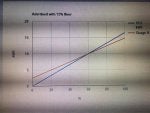I’m curious about the specs of the battery and how much “provisioning” is built into the design of the charging system.
I’ve seen from numerous sources that the battery is spec’d at 16kWh of capacity with 96 cells, but since there are no user settings for adjusting how low it can deplete or how full the system charges the battery, we have to assume that the engineers at Chrysler put sufficient cycle-life provisioning in place so that we get a lot of life out of the battery. That said, I’m still curious how the system works and where the set points really are.
I’ve noticed the system reports 100% and 1% for a lot longer than feasible so I’m convinced there is some kind of User eXperience curve applied to the actual reported capacity value. I’ve seen a few posts where people say that a reported 100% is closer to actual 80% and reported 0% is closer to actual 20%. While I’m convinced there is offset headroom provisioning at the high and low end I’m really curious about what the actual numbers are.
I have a Juice Box Pro 40 which has data logging of the charge current over time so this data is feeding my curiosity. I have a 2018 with about 500 miles on it so I have very little data and brand new batteries.
I have done a few electric only commutes to work now and when I get to 0 percent, the 240v charger puts a reported 13.2 kWh in to get back to “reported 100%”
2.8 out of 16kWh (at reported 0%) would mean there is actually 17.5% left for the hybrid system to manage electric only starts in city driving while keeping the battery from going fully depleted which is known to be hard on lithium Ion batteries.
The other bit of data I have is that the system doesn’t go into a slow roll off when it gets close to 100% (reported) charge. When you fully charge a 96 cell, battery managment systems often employ “load balancing” to keep any one of the 96 cells from getting over charged. To charge, the system applies a large DC voltage across all 96 cells in series and if one cell has less total capacity it will fill up before the others and get damaged. To deal with this the cells BMS will bleed off some of the extra which creates heat, also when batteries get near full capacity, charge systems apply a constant voltage and the the charge power starts ramping down at some rolloff dictated by the battery chemistry.
When my 2013 Nissan Leaf charges at 6.5kW to 100%, there is a knee around 92% where it rolls off and takes an hour to get the last ~2kWh of charge.
When the Pacifica is charged to 100% it stays pretty steady at 6.7kW and then for the last 8 minutes it first cuts immediately to half of that charge power, and then has a linear ramp to 0.
So my best guess is that the charge system is not putting the battery into Constant Voltage mode where it has to rely on load balancing, but it is cutting off the charge somewhere well before where a 6.7kW charge would normally roll-off if the battery was in Constant Voltage charge mode.
So I’m really curious what the actual design parameters are. Is the 16kWh battery really a 17.4 kWh where 92% is really 100% and 0% is really 17.5%? Or is it biased more towards the lower end? Or is 0% = 20% and 100% is 80% like I’ve read in some “hand wavy” posts..
Does anyone have the real spec numbers for the battery management system? Does the BMS do load balancing? Is the published capacity de-rated? Is any of this in the service manual?
I’ve seen from numerous sources that the battery is spec’d at 16kWh of capacity with 96 cells, but since there are no user settings for adjusting how low it can deplete or how full the system charges the battery, we have to assume that the engineers at Chrysler put sufficient cycle-life provisioning in place so that we get a lot of life out of the battery. That said, I’m still curious how the system works and where the set points really are.
I’ve noticed the system reports 100% and 1% for a lot longer than feasible so I’m convinced there is some kind of User eXperience curve applied to the actual reported capacity value. I’ve seen a few posts where people say that a reported 100% is closer to actual 80% and reported 0% is closer to actual 20%. While I’m convinced there is offset headroom provisioning at the high and low end I’m really curious about what the actual numbers are.
I have a Juice Box Pro 40 which has data logging of the charge current over time so this data is feeding my curiosity. I have a 2018 with about 500 miles on it so I have very little data and brand new batteries.
I have done a few electric only commutes to work now and when I get to 0 percent, the 240v charger puts a reported 13.2 kWh in to get back to “reported 100%”
2.8 out of 16kWh (at reported 0%) would mean there is actually 17.5% left for the hybrid system to manage electric only starts in city driving while keeping the battery from going fully depleted which is known to be hard on lithium Ion batteries.
The other bit of data I have is that the system doesn’t go into a slow roll off when it gets close to 100% (reported) charge. When you fully charge a 96 cell, battery managment systems often employ “load balancing” to keep any one of the 96 cells from getting over charged. To charge, the system applies a large DC voltage across all 96 cells in series and if one cell has less total capacity it will fill up before the others and get damaged. To deal with this the cells BMS will bleed off some of the extra which creates heat, also when batteries get near full capacity, charge systems apply a constant voltage and the the charge power starts ramping down at some rolloff dictated by the battery chemistry.
When my 2013 Nissan Leaf charges at 6.5kW to 100%, there is a knee around 92% where it rolls off and takes an hour to get the last ~2kWh of charge.
When the Pacifica is charged to 100% it stays pretty steady at 6.7kW and then for the last 8 minutes it first cuts immediately to half of that charge power, and then has a linear ramp to 0.
So my best guess is that the charge system is not putting the battery into Constant Voltage mode where it has to rely on load balancing, but it is cutting off the charge somewhere well before where a 6.7kW charge would normally roll-off if the battery was in Constant Voltage charge mode.
So I’m really curious what the actual design parameters are. Is the 16kWh battery really a 17.4 kWh where 92% is really 100% and 0% is really 17.5%? Or is it biased more towards the lower end? Or is 0% = 20% and 100% is 80% like I’ve read in some “hand wavy” posts..
Does anyone have the real spec numbers for the battery management system? Does the BMS do load balancing? Is the published capacity de-rated? Is any of this in the service manual?



















